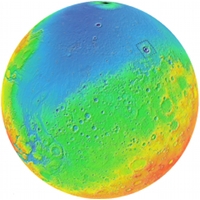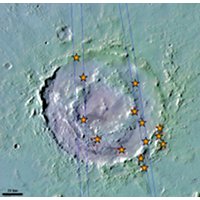Impacts reveal minerals from warm, wet Mars
24 June 2010
An international team, led by European scientists, has found new evidence confirming that conditions favourable to life once existed all over Mars. Detailed studies of hydrated minerals found inside impact craters show that liquid water was widespread not only in the southern highlands, but also beneath the planet's northern plains.There are many differences between the ancient terrain south of the Martian equator and the younger lowlands of the north. Data sent back by ESA's Mars Express and NASA's Mars Reconnaissance Orbiter have shown that the surface of the Noachian-aged southern highlands has been largely unaltered over billions of years.
In these regions the spacecraft have discovered thousands of small outcrops where rock minerals have been altered by water. Many of these were in the form of hydrated clay minerals known as phyllosilicates. Clearly, the southern hemisphere of Mars was once much warmer and wetter than it is today.
However, until this week, no sites with hydrated silicate minerals had been confirmed in the northern lowlands, where a thick blanket of lava and sediments up to several kilometers thick hampers efforts to probe the underlying bedrock.
The first hints that hydrated silicates may exist beneath the northern plains were provided by the OMEGA (Observatoire pour la Minéralogie, l'Eau, les Glaces et l'Activité) spectrometer on board Mars Express. However, the outcrops were small and more detailed observations were required to confirm their existence. The OMEGA team began to sift through higher resolution data from CRISM (Compact Reconnaissance Imaging Spectrometer for Mars), an instrument on board NASAfs Mars Reconnaissance Orbiter.
Their search concentrated on sizeable impact craters where incoming asteroids had blasted up to several kilometers through the overlying mantle, exposing ancient crustal material. The researchers targeted all craters with diameters greater than 30 km for which CRISM data were available, and dozens of craters with diameters ranging from 4 to 30 km. After excluding observations of sites covered by seasonal ice, this left a total of 91 large craters.
As reported this week in the journal Science, at least nine of the surveyed craters were found to contain phyllosilicates or other hydrated silicates. These minerals, which formed in wet environments on the surface or underground, were identical to those found in the southern hemisphere.
"We can now say that the planet was altered on a global scale by liquid water more than 4 billion years ago," said John Carter of the University of Paris, the report's lead author.
With the small sample of widely scattered sites, it is difficult to draw conclusions about the type of environment that existed on the northern plains over 4 billion years ago. However, the nature and locations of the minerals provide some clues. In addition to hydrated minerals, all of the large craters have strong signatures of the mineral olivine, both in their bedrock and in dark dunes on the crater floors in close proximity to the hydrated mineral deposits.
"The results suggest that the phyllosilicates formed after the Martian dichotomy was created, possible by a huge impact," said Jean-Pierre Bibring, the OMEGA Principal Investigator from the University of Paris. "They are rich in iron and magnesium, but less so in aluminium. Together with the close proximity of olivine, which is easily modified by water, this indicates that the exposure to water lasted only tens to hundreds of millions of years. The potential habitability of Mars did not last long, but remarkably, its record is still preserved in phyllosilicate-rich spots."
"There was probably a fairly small amount of non-acidic water, but it would have been widespread across the surface," he added. "In the North, the hydrated minerals were later buried beneath a thick layer of lava and sediments, so now we only see phyllosilicates where they have been exhumed by large impacts."
The global presence of water during the early history of Mars suggests that conditions may have been favourable for the evolution of primitive life on the Red Planet. Sites where hydrated minerals have been confirmed, including the craters in the northern hemisphere, are interesting sites for future space missions.
"NASA and the scientific community are currently discussing future landing sites for NASA's Mars Science Laboratory rover, and in the near future we will start the discussions about the landing site for ESA's ExoMars rover," explained Olivier Witasse, Project Scientist for Mars Express. "Possible candidates are sites where phyllosilicates have been found and there might be a possibility for discovering signs of past Martian life."
A number of scientists have suggested that the lava-coated northern plains were subsequently covered by a wide, but fairly shallow ocean, perhaps 3.5 billion years ago. However, no evidence in support of this postulated ocean is provided by the new results.
"Our studies do not find any signs of the lava plains in the north being altered by water," said Jean-Pierre Bibring. "This shows that the surface water was stable all over the planet before the lava outflow covered the northern plains. However, the huge floods that later came down from the highlands must have rapidly evaporated or percolated down into the ground instead of creating a northern ocean."
The search for more northern craters containing hydrated material is continuing, though any future detections are likely to involve only small deposits.
The report's other authors are Francois Poulet, also from the University of Paris, who was the lead author of the first OMEGA discovery of phyllosilicates on Mars, and Scott Murchie of Johns Hopkins University Applied Physics Laboratory, Laurel, Maryland, the CRISM Principal Investigator.
These results are reported by Carter et al., in "Detection of hydrated silicates in crustal outcrops in the northern plains of Mars" published in the 24 June 2010 issue of Science.
Contacts
Jean-Pierre Bibring, OMEGA Principal Investigator
Institut d'Astrophysique Spatiale - IAS Orsay, France
Email: jean-pierre.bibring![]() ias.u-psud.fr
ias.u-psud.fr
Olivier Witasse, Mars Express Project Scientist
Research and Scientific Support Department
Directorate of Science & Robotic Exploration
European Space Agency
Email: Olivier.Witasse![]() esa.int
esa.int



